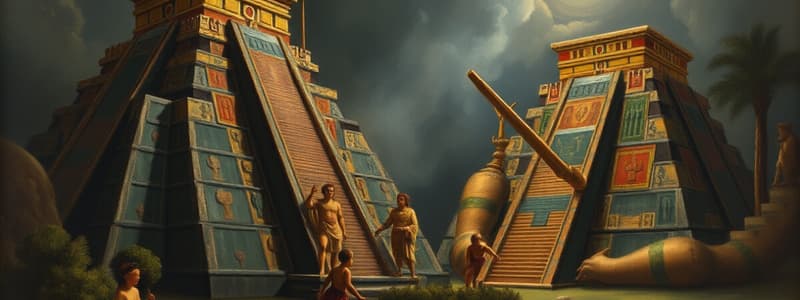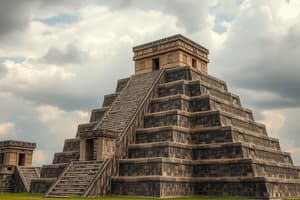Podcast
Questions and Answers
What is Mesoamerica?
What is Mesoamerica?
- A geographic region in the western hemisphere (correct)
- A method of farming
- A civilization in South America
- A type of architecture
What was the first Mesoamerican civilization?
What was the first Mesoamerican civilization?
Olmec
What is chavin known for?
What is chavin known for?
Architecture and drainage systems
What civilization is associated with the Yucatan Peninsula?
What civilization is associated with the Yucatan Peninsula?
The method of agriculture that involves cutting trees and burning them is called ______.
The method of agriculture that involves cutting trees and burning them is called ______.
What are chinampas?
What are chinampas?
What was the main purpose of quipu in the Inca civilization?
What was the main purpose of quipu in the Inca civilization?
Obsidian is used for building large structures.
Obsidian is used for building large structures.
Which of the following is true about Teotihuacan?
Which of the following is true about Teotihuacan?
What does the term 'mita' refer to in the Incan Empire?
What does the term 'mita' refer to in the Incan Empire?
What type of agricultural method is shifting cultivation?
What type of agricultural method is shifting cultivation?
Match the following terms with their descriptions:
Match the following terms with their descriptions:
Flashcards are hidden until you start studying
Study Notes
Mesoamerica and Civilizations
- Mesoamerica is the geographic region where the Mayan and Aztec civilizations thrived.
- The Olmec civilization (ca. 1200-400 B.C.E.) is recognized as the first in Mesoamerica, renowned for its agriculture, trade networks, ceremonial centers, and monumental architecture.
- Teotihuacan, an important Olmec city, collapsed around 800 CE and is famous for the Pyramid of the Sun.
South American Civilizations
- Chavin was a notable pre-Incan civilization known for its distinct architecture and advanced drainage systems developed in the Andean region of present-day Peru.
- The Moche civilization flourished on the northern coast of Peru from 200-700 C.E., noted for its irrigation networks and significant urban centers anchored by brick temples.
Maya Civilization
- The Maya established major cities like Chichen Itza and Tikal in the Yucatan Peninsula, relying heavily on agriculture and trade.
- Religious practices were polytheistic, involving human sacrifice, and they developed advanced calendars, written languages, and numerical systems.
- Key elements included slash-and-burn agriculture for soil enrichment, chinampas (raised fields) for increased yields, and the sacred jaguar.
Cultural Practices and Artifacts
- Human sacrifice played a central role in the religious beliefs of both the Aztec and Maya civilizations.
- The Maya used hieroglyphs, comprising around 800 symbols, to record significant historical events in codices.
- The Popul Vuh encapsulates Maya cosmology, teaching that gods created humans from maize and water.
Incan Innovations
- The Inca utilized chasquis, runners who delivered messages across their extensive empire.
- Quipu, a system of knotted strings, was employed for recording numerical data.
- The mita system required able-bodied citizens to contribute labor to the state periodically.
Key Geographical Features
- Lake Texcoco was the site where the Aztec capital, Tenochtitlan, was established, a city later becoming Mexico City.
- The Yucatan Peninsula served as the heart of Maya civilization.
Key Deities and Beliefs
- Quetzalcoatl, the feathered serpent deity of the Aztecs, was associated with nature and agriculture, prophesized to return after his disappearance.
- Huitzilopochtli was a central god for the Aztecs, integral to human sacrifice and warfare traditions.
Sociopolitical Structures
- The Toltecs emerged as a militaristic people establishing Tula; they practiced extensive human sacrifice.
- The concept of stratification indicates the hierarchical organization present in these societies.
Agricultural Practices
- Slash-and-burn farming involves cutting down and burning trees to enrich the soil for crop cultivation.
- Shifting cultivation allows farmers to clear lands for growing crops until soil fertility declines, after which they move to new areas.
Studying That Suits You
Use AI to generate personalized quizzes and flashcards to suit your learning preferences.




